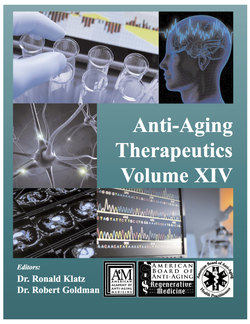Читать книгу Anti-Aging Therapeutics Volume XIV - A4M American Academy - Страница 33
На сайте Литреса книга снята с продажи.
TESTOSTERONE DELIVERY VIA PELLETS
ОглавлениеTestosterone can be delivered in a number of ways: topically (compounded or commercial), by injection, via patches, sublingually, or by pellet implantation. Each method has advantages and disadvantages. Table 1 lists the advantages and disadvantages associated with the use of commercial gels, compounded creams and gels, and injectable testosterone.
| Table 1. Advantages and Disadvantages of Different Methods of Testosterone Administration | ||
| Commercial Gels (Testim or Androgel) Advantages: •Well-absorbed; •May be more easily covered by insurance; •Single-use tubes, packets, or pumps. Disadvantages: •Strong alcohol odor; •Fixed dosages – not customizable; •Very expensive if not covered by insurance; •Limited to only 1 type of vehicle delivery (a problem if allergic to the gel); •Requires daily compliance – drop-out rate is a factor. | Compounded Creams and Gels Advantages: •Well-absorbed; •Dosage is customizable; •Multiple delivery forms (pumps, Topi-Click® syringes, tubs (with 1/8+ or 1/4 tsp spoons); •May be covered by insurance, but if not, not too expensive; •Multiple hypoallergenic vehicles available if skin allergy is a problem. • Disadvantages: •Thicker than commercial gels – hairy patients may have problems; •Lack of large multicenter studies; •Available only from quality compounded pharmacies (often requiring mail order); •Not uncommon adverse reactions include acne in both sexes and facial hair growth in women; •Aromatization concerns in men often requiring aromatase inhibition. | Injectable Testosterone Advantages: •May be covered by insurance but if not, inexpensive; •Available from all pharmacies; •Well-absorbed when delivered subcutaneously or intramuscularly; •Dosage is customizable; •Administration is not daily—once or twice weekly injections. Disadvantages: •Common adverse reactions include acne in both sexes (face and body), facial hair growth in women, and aggressiveness; •Commonly occurring aromatization to estradiol in men, very often requiring aromatase inhibition. •Pain with injection (not accepted by most women and many men); •Scar tissue/lipomas common form over time in the gluteal muscles; sometimes this interferes with selection of sites for injection |
The first published reports on TPI were in the 1940’s making it one of the first, if not the first, forms of bioidentical hormone replacement therapy. Pellets have the highest consistency of delivery of any form of hormone administration. Clinical trials show that TPI results in therapeutic hormone levels within just 24-hours, and most people feel a difference within 24 to 48-hours, although in some it may take up to 14-days. Pellets usually last for 4-months in women and between 4 and 5-months in men. Pellets do not need to be removed, as they completely dissolve over time. In the event of problems the active metabolites estradiol (E2) and DHT can be impeded by 5-alpha-reductase and aromatase inhibitors.
Reported major advantages associated with TPI include:
•Physiological hormone release – healthy young males produce 6-9 mg/day testosterone, the release rate of a 100 mg testosterone implant is ≈ 0.6 mg/day, therefore 12 x 100 mg pellets will provide > 7 mg/day testosterone;
•Elevations of DHT or E2 are uncommon in those whose levels are normal before TRT is begun;
•Suppression of follicle stimulating hormone (FSH) and luteinizing hormone (LH) is dose-dependent and correlates with clinical effects. As with other forms of testosterone administration the suppression of LH may cause the testicles to decrease in size, although this is much less common than with injections or creams in the author’s experience. In theory, letrozole (Femara®) may prevent this, but human chorionic gonadotrophin (HCG) is the more common method of maintaining testicular size if desired;
•Lack of weekly swings in testosterone levels (which are commonly seen with intramuscular (IM) injections);
•Testosterone implants help to maintain bone mineral density (BMD) – a single implantation with 1200 mg of testosterone has been shown to be more effective in increasing BMD than oral or IM testosterone in men with primary hypogonadism
•Minimal complications – extrusion <1%-8% (early heavy physical activity involving the gluteal muscles is a predisposing factor for extrusion, thus patients are encouraged to avoid heavy physical activity for 3-days post implantation), minor bleeding 0-2%, minor infection 1-5% - complication rate is related to operator skill;
•There is no scarring to interfere with further implants
•Consistency, compliance (continuation rate of 93%), and convenience – implantation of pellets is a minor procedure (takes approximately 5 minutes) and causes minimal discomfort. Patients require implants just 2 or 3 times a year.
The only real disadvantage associated with TPI is the difficulty in removing pellets if necessary, for example if the patient is diagnosed with prostate cancer while pellets are present. For that reason, at the time of initial evaluation, if prostate specific antigen (PSA) is elevated to the high-normal or above-normal range it is wise to treat with an alternative method of TRT and recheck PSA in 2-3 months. If PSA has remained stable pellet implantation should be safe. If there are any concerns the patient should be referred for a urological consultation.
